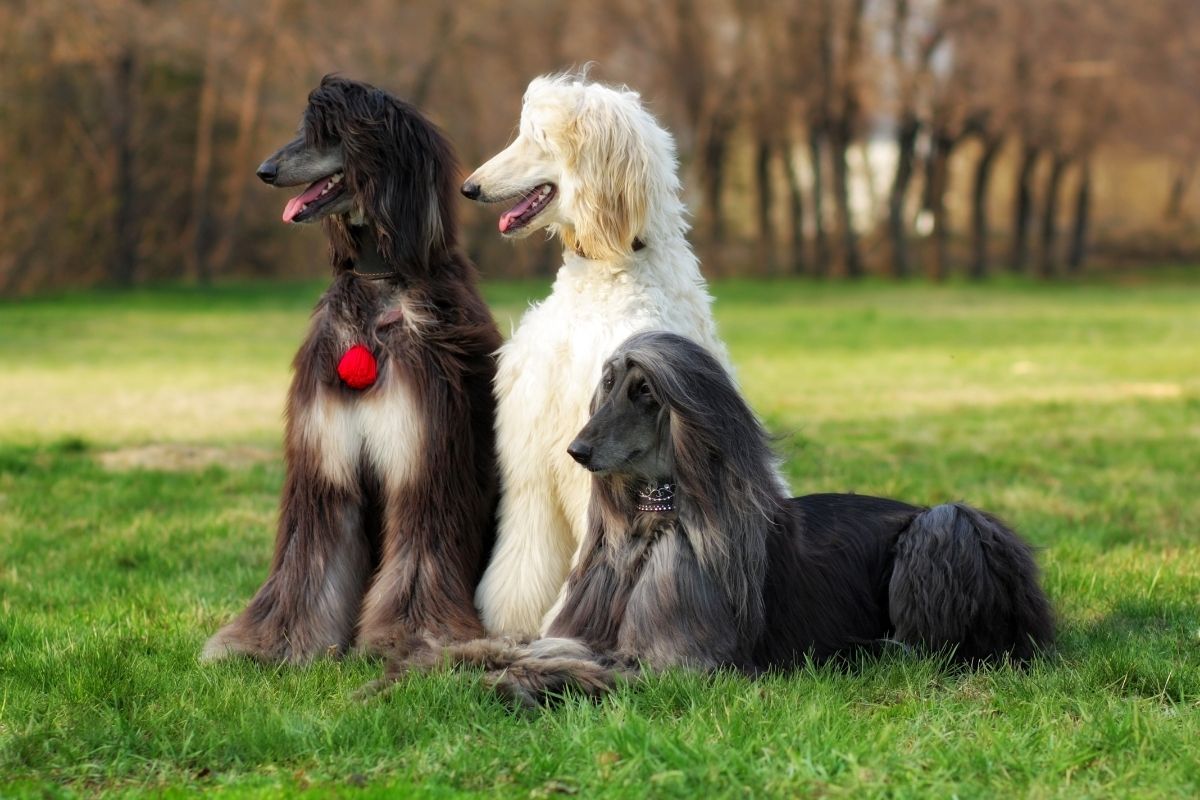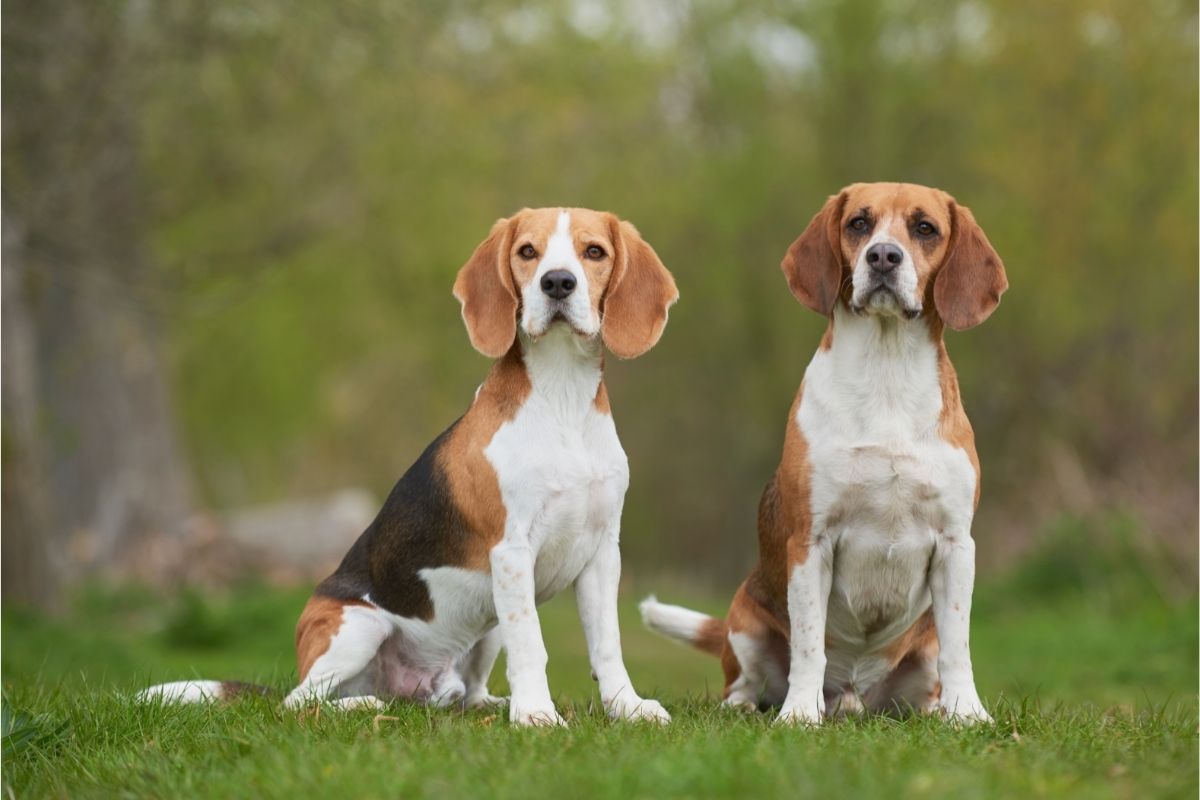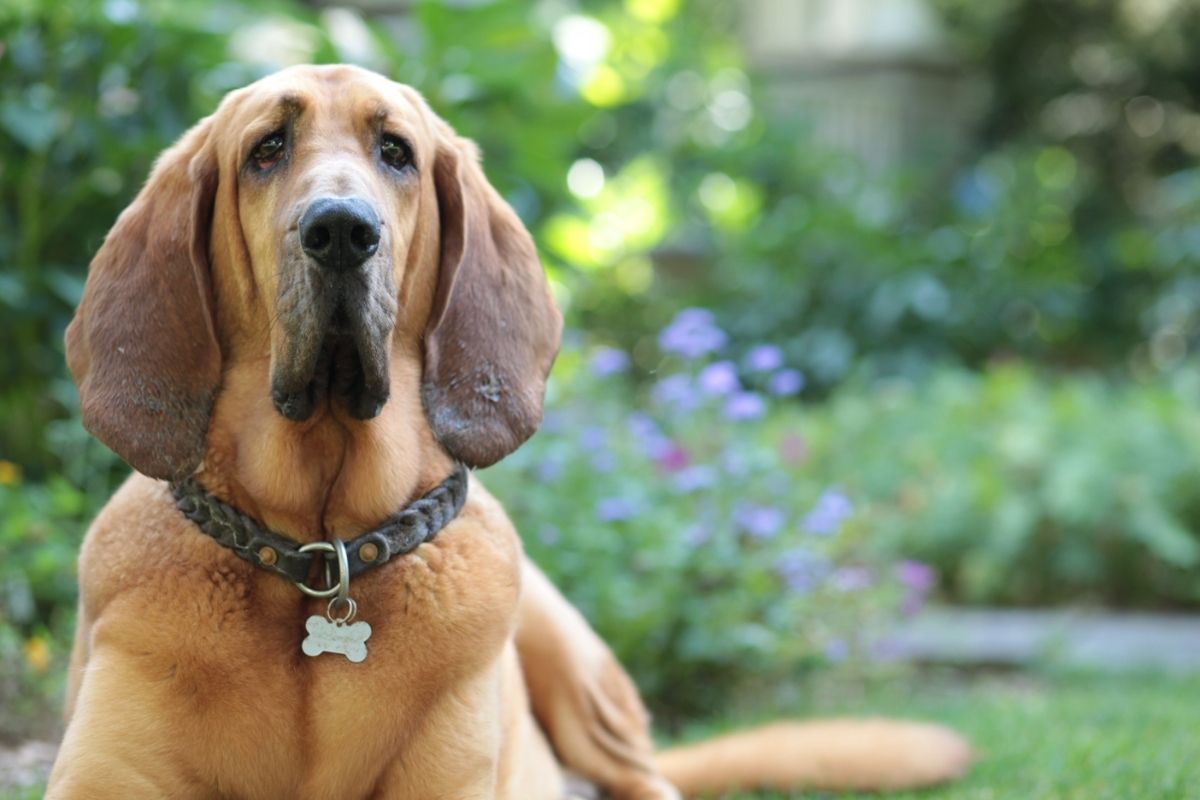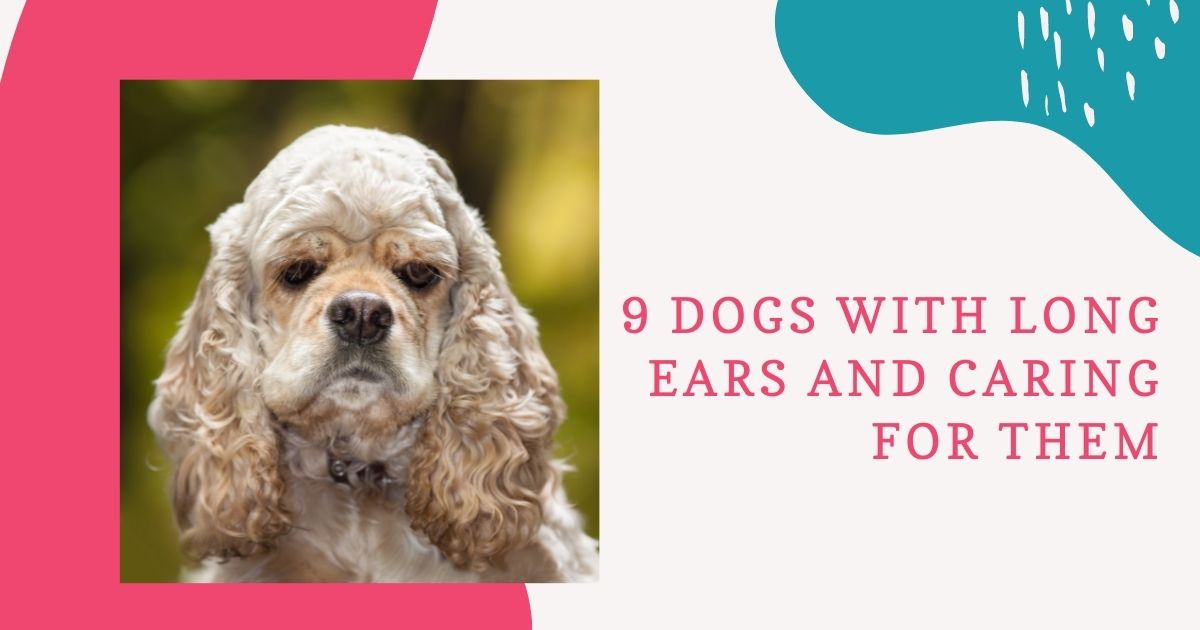Long-Eared Dogs
Dogs with long ears are beautiful and fun to have around you. However, ear infections are more likely to affect them. When you add in swimming, regular bathing, or skin allergies, the chances of infection rise even more.
Is it necessary for you to clean your dog’s ears? Yes, it is essential. The grooming process often overlooks ear care; here’s all you need to know about caring for your dog’s ears.
9 Dog Breeds With Long Ears
Afghan Hound
Overview of the Breed
Height: 25-27 inches (63.5-68.6 centimeters)
Weight: 50-60 pounds (22.7-27.2 kilograms)
Physical characteristics: Has a long, thick, and silky coat that can be of any color or combination of colors, including brindle and domino.
The origin of this ancient species is difficult to pinpoint because they have been in existence long before people began writing about them. What we do know is that they come from Afghanistan and its regions. You can identify them by their long flowing ears and their luxurious coat.
Afghans can suit best in homes that have the time to devote to taking care of them because their long-haired coats require a lot of attention.

American Cocker Spaniel
Overview of the Breed
Height: 14-15 inches (35.6-38.1 centimeters)
Weight: 20-30 pounds (9.1-13.6 kilograms)
Physical characteristics: Has a silky and flat or slightly wavy coat with feathers on the ears, chest, belly, and legs.
Spaniels with long ears, such as the American Cocker Spaniel, Field Spaniel, and Welsh Springer Spaniel, are relatively common. The joyful mood, curly-haired ears, and kid-friendly personality of the American Cocker Spaniel make them popular family pets.
Basset Hound
Overview of the Breed
Height: 15 inches (38.1 centimeters)
Weight: 40-65 pounds (18.1-29.5 kilograms)
Physical characteristics: Has a short coat with black/mahogany, white, brown/tan, red, and lemon color combinations.
This is a breed that many people love. They love them for their amiable attitude as well as their remarkable ears. Their ability to track scents is second only to the Bloodhound, and their long, floppy ears undoubtedly contribute to that. If you own one, prepare for some obstinacy, as this is a common trait of the breed.
Beagle
Overview of the Breed
Height: 15 inches (38.1 centimeters)
Weight: 20-25 pounds (9.1-11.3 kilograms)
Physical characteristics: Has a short coat that can be tri-color (tan, black, and white), red and white, and lemon and white.
Beagles are one of the most popular dogs with long ears breeds globally. They have an excellent reputation since they are great family pets with easygoing personalities and an aptitude for adapting to new situations. We believe those adorable long, floppy ears of the long-eared beagle have something to do with it.

Bloodhound
Overview of the Breed
Height: 23-27 inches (58.4-68.6 centimeters)
Weight: 90-110 pounds (40.8-49.9 kilograms)
Physical characteristics: Has a short, dense, and loose coat with numerous folds around the face, neck, and ears.
The Bloodhound is perhaps the most popular long-eared dog. Since the Middle Ages, this huge and friendly breed has been helping humans in scent hunting. Ear infections are common in bloodhounds, so it’s important to keep dirt, debris, and bacteria out of the folds and canals of their delicate and impressive ears.

Havanese
Overview of the Breed
Height: 8.5-11.5 inches (21.6-29.2 centimeters)
Weight: 7-13 pounds (3.2-5.9 kilograms)
Physical characteristics: The coat can be silky straight or highly wavy with ringlets, and it can come in a range of colors.
Havanese is one of the smaller breeds on this list, with long ears proportionate to their stature and a silky coat that requires regular care. Although there is no such thing as a genuinely hypoallergenic dog, Havanese shed very little hair.
Lhasa Apso
Overview of the Breed
Height:10-11 inches (25.4-27.9 centimeters)
Weight: 12-18 pounds (5.4-8.2 kilograms)
Physical characteristics: Has a dense double coat in practically any color, the most common being black, white, gold, gray, cream, or a combination of these colors.
The Lhasa Apso is a petite breed with a dense, resilient coat and some enormous ears. They originated in Tibet more than 2,500 years ago. They are short dogs with long ears. Their ear fur is longer than their ears, so they regularly check it for knots and dirt. This is another breed that requires a lot of grooming, but luckily, they don’t shed much.
Treeing Walker Coonhound
Overview of the Breed
Height: 20–27 inches (50.8-68.6 centimeters)
Weight: 50-70 pounds (22.7-31.8 kilograms)
Physical characteristics: They have a smooth and short coat that is white, black, or tan tri-color.
The Treeing Walker Coonhound has long ears, a common characteristic among Coonhound breeds. This bright American working breed aids humans in hunting by using their remarkable ears and distinguishing bark. When it comes to recall training, you may need to put in a little more effort, like many scent hounds.

Weimaraner
Overview of the Breed
Height: 23-27 inches (58.4-68.6 centimeters)
Weight: 55-90 pounds (24.9-40.8 kilograms)
Physical characteristics: They have a short, stiff coat in various gray colors.
The Weimaraner is an elegant and lovable sports breed with fascinating eyes and ears that come in handy when hunting. Their silky, huge ears resulted from interbreeding with Bloodhounds in the past, but they’ve now come up with their characteristics, and their length is more controllable.
Weimaraners are athletic and lively dogs who require a home that can provide them with adequate exercise and stimulation to avoid developing undesirable behaviors.
The following table summarizes the breed characteristics of the nine dog breeds with long ears.
| Breed | Height | Weight | Coat color | Lifespan | Origin |
| Afghan Hound | 25 – 27 inches (63.5-68.6 centimeters) | 50 – 60 pounds (22.7-27.2 kilograms) | Any color or combination of colors, including brindle and domino | 12 to 14 years | Afghanistan |
| American Cocker Spaniel | 14-15 inches (35.6-38.1 centimeters) | 20 – 30 pounds (9.1-13.6 kilograms) | Combinations of black, tan, white, brown, red, silver, buff, and brown roan with/without roan and merle markings | 10 to 14 years | United States |
| Basset Hound | 15 inches (38.1 centimeters) | 40 – 65 pounds (18.1-29.5 kilograms) | Combinations of black, brown, tan, white, lemon, mahogany, and red | 12 to 13 years | France |
| Beagle | 15 inches (38.1 centimeters) | 20 – 25 pounds (9.1-11.3 kilograms) | Tricolor combinations can include tan, black, white, reddish-brown, and pale lemon | 10 to 15 years | England |
| Bloodhound | 23–27 inches (58.4-68.6 centimeters) | 90 – 110 pounds (40.8-49.9 kilograms) | Black and tan, liver and tan, or red | 10 to 12 years | France |
| Havanese | 8.5-11.5 inches (21.6-29.2 centimeters) | 7-13 pounds (3.2-5.9 kilograms) | One or two colors including black, silver, white, cream, tan, fawn, gold, sable, or red | 14 to 16 years | Cuba |
| Lhasa Apso | 10-11 inches (25.4-27.9 centimeters) | 12-18 pounds (5.4-8.2 kilograms) | Black, black and tan, cream, golden, grizzle, red, red gold, or white, black tips, brindle, sable, black mask with tips. | 12 to 15 years | Tibet |
| Treeing Walker Coonhound | 20–27 inches (50.8-68.6 centimeters) | 50-70 pounds (22.7-31.8 kilograms) | White, black, and tricolor with various markings | 12 to 13 years | United States |
| Weimaraner | 23–27 inches (58.4-68.6 centimeters) | 55-90 pounds (24.9-40.8 kilograms) | Various shades of gray | 11 to 13 years | Germany |
Ear Care for Long-Eared Dog Breeds – Top Tips
Many dogs with long floppy ears do not like it when you touch or clean their ears. So, first and foremost, get your dog used to you touching their ears. If your dog is a puppy, this is a lot easier! However, with a bit of patience and a few treats, your dog could be able to accept it.
Begin by gently massaging their pinna, lifting it, and rubbing around the ear canal’s opening. Once your dog is comfortable with this routine, you may utilize it daily to look for any signs of illness.
In particularly long-eared dogs, the skin at the end of the pinna can become red and painful. This can occur due to the ears dragging along the ground or repetitive rubbing on items as they pass. Consult your veterinarian if you notice any strange marks or redness on your dog’s ears.
Keep an eye on your dog’s pinnae. You might realize that they sometimes become wet. This may result from getting into the water bowl as they drink water. Always dry them often to prevent your dog from getting skin infections.
Brushing your dog’s ears should be part of your regular grooming practice if your dog has lengthy fur. Because the pinna’s skin is so delicate, use a soft-bristled brush to clean it.
Also, if you notice any mats, you should take your dog to a groomer to help you remove them.
How Do I Clean My Dog’s Ears at Home?
To clean your dog’s ears at home, you will need cotton wool pads, a dog ear cleaner, and some goodies for your dog. It is advisable to have an extra pair of hands; however, you can do the cleaning independently if your dog is cooperative.
Cleaners that have alcohol as an ingredient can irritate the skin of certain dogs’ ear canals, especially if they are already inflamed. Choose a dog ear cleaner that is gentle and of good quality. Consult your veterinarian if you do not know the right ear cleaner for your dog with long floppy ears.
Before you begin cleaning your dog’s ear, examine their pinna first. Are there any odd bumps or marks? After that, carefully lift the flap to reveal the ear canal hole. Stop and visit your veterinarian if there is any redness, excessive dark wax, or a foul odor. If the pinna is in good condition, you can do the cleaning following the steps:
- Let’s begin with the pinna. To clean the inner surface of your dog with long ears, use ear cleaning wipes. Examine the fur for grass seeds, burrs, or mats. If necessary, get professional help to deal with these issues. Never pluck the hair on the ear canals of your dog. This is occasionally necessary, such as in the case of recurring infections, but only under the supervision of a veterinarian. Otherwise, it’s preferable to leave the hairs alone. Plucking them can create irritation and inflammation, leading to an infection that otherwise would not have occurred!
- With one hand, gently lift the pinna. Gently insert the tip of the ear cleaner nozzle into the ear canal entrance with the other hand. Only the tip needs to go in, so be careful not to push it too deep. Squeeze the bottle harder, ensuring that the cleaning solution fills the ear canal.
- Massage the base of the ear for about 20 seconds with your thumb behind it and your fingers in front of it. You’ll hear a squelching noise if you’re in the right spot! This ensures that the ear cleaner is evenly distributed throughout the canal and dislodges any wax.
- Allow your dog to shake his head! (It’s best to avoid washing near expensive carpets or furniture!)
- Using a cotton wool pad or ear cleansing wipes, remove any excess wax from the ear canal entrance and pinna. DO NOT insert cotton wool or cotton tips into the canal; they will push the wax deeper into the canal, perhaps causing injury!
- Give a treat to your dog. You can now repeat the same procedure with the other ear. Stop and make an appointment with your veterinarian if your dog displays signs of pain during the process. This could signal an issue you can’t see, such as an infection.
How Often Should I Clean My Dog’s Ears?
This is quite a challenge to many owners of dogs with long droopy ears. You should clean your dog’s ears frequently enough to avoid infections, but not so often that you irritate their ear canal. Should you clean your dog’s ears every day? Owners frequently inquire. The answer is no! You should not do this unless your veterinarian has said so.
For most dogs with healthy ear canals, once a month is sufficient. This, however, varies by breed, swimming ability, ear wax production, underlying allergies, and previous ear infections. Your veterinarian is ideal for providing you with advice because they can customize the cleaning plan to your dog’s specific needs.
How Will I Know if My Dog Has an Ear Infection?
If your dog appears to have an ear infection, do not attempt to clean or treat it at home. The following are warning signs to look out for:
- Shaking of the head
- A tilted head
- Scratching of the ears
- Rubbing his face on the floor
- A swollen ear flap
- Redness
- Excess wax or wax of a different color than typical
- Ears that stink
- Hearing impairment
If you detect any of these symptoms, schedule an appointment with your veterinarian as soon as possible.
The Final Say
It is incredible to own dog breeds with long ears. It is even more exciting to have tips to help you take good care of their long and beautiful ears. You should examine and clean your dog’s ears regularly with the information in this article. If you notice anything unusual, contact your veterinarian.
If your dog refuses cleaning, consult your veterinarian to discover if there is a problem. Your veterinarian or veterinary nurse can also provide future ear-cleaning guidance. If you do this, both you and your dog will live happily.

